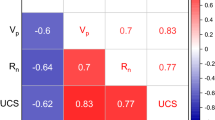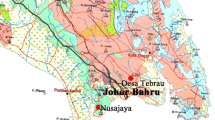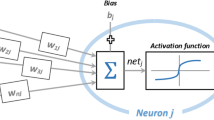Abstract
The accurate determination of uniaxial compressive strength (UCS) plays a vital role in the initial design phase of rock engineering and rock geotechnics. Traditionally, this assessment entails costly, time-intensive and labor-demanding experimental tests. Consequently, there is significant promise in exploring machine learning techniques for UCS prediction, warranting further investigation. This study aims to introduce an innovative machine-learning approach and an intelligent system for forecasting UCS based on various granite rock datasets. To achieve this, a novel hybrid model is proposed by combining Marine Predators Algorithm (MPA) and artificial neural network (ANN), and then resulting in an intelligence system. Additionally, forty-nine empirical formulas, including fourteen developed in this study and thirty-five from prior literature, are considered. The input variables for the model comprise the Point load strength index (Is(50)), Schmidt hammer rebounded number (RL) and P wave velocity (Vp), while the UCS serves as the output variables. The obtained results show that the MPA-ANN model exhibits superior performance compared to other prediction models. Furthermore, a user-friendly intelligence system is developed using MATLAB programming. This research stands as a compelling demonstration of the efficacy of a combined supervised learning approach and swarm intelligence algorithms in addressing engineering challenges, such as UCS prediction. It has the potential to offer valuable support for practical applications in the field and further explorations in the domain of rock mechanics studies.










Similar content being viewed by others
Data availability
The datasets generated during and/or analysed during the current study are available from the corresponding author on reasonable request.
References
Abdi Y, Garavand AT, Sahamieh RZ (2018) Prediction of strength parameters of sedimentary rocks using artificial neural networks and regression analysis. Arab J Geosci 11. https://doi.org/10.1007/s12517-018-3929-0
Ali E, Guang W, Ibrahim A (2014) Empirical relations between compressive strength and microfabric properties of amphibolites using multivariate regression, fuzzy inference and neural networks: a comparative study. Eng Geol 183:230–240. https://doi.org/10.1016/j.enggeo.2014.08.026
Amiri M, Bakhshandeh Amnieh H, Hasanipanah M, Mohammad Khanli L (2016) A new combination of artificial neural network and K-nearest neighbors models to predict blast-induced ground vibration and air-overpressure. Eng Comput 32:631–644. https://doi.org/10.1007/s00366-016-0442-5
Armaghani DJ, Tonnizam Mohamad E, Momeni E et al (2016) Prediction of the strength and elasticity modulus of granite through an expert artificial neural network. Arab J Geosci 9:1–16. https://doi.org/10.1007/s12517-015-2057-3
Astarita V, Haghshenas SS, Guido G, Vitale A (2023) Developing new hybrid grey wolf optimization-based artificial neural network for predicting road crash severity. Transp Eng 12:100164. https://doi.org/10.1016/j.treng.2023.100164
Barham WS, Rabab’ah SR, Aldeeky HH, Al Hattamleh OH (2020) Mechanical and physical based artificial neural network models for the prediction of the unconfined compressive strength of rock. Geotech Geol Eng 38:4779–4792. https://doi.org/10.1007/s10706-020-01327-0
Barzegar R, Sattarpour M, Deo R et al (2020) An ensemble tree-based machine learning model for predicting the uniaxial compressive strength of travertine rocks. Neural Comput Appl 32:9065–9080. https://doi.org/10.1007/s00521-019-04418-z
Basu A, Aydin A (2006) Predicting uniaxial compressive strength by point load test: significance of cone penetration. Rock Mech Rock Eng 39:483–490. https://doi.org/10.1007/s00603-006-0082-y
Ceryan N (2014) Application of support vector machines and relevance vector machines in predicting uniaxial compressive strength of volcanic rocks. J African Earth Sci 100:634–644. https://doi.org/10.1016/j.jafrearsci.2014.08.006
Ceryan N, Okkan U, Kesimal A (2012) Application of generalized regression neural networks in predicting the unconfined compressive strength of carbonate rocks. Rock Mech Rock Eng 45:1055–1072. https://doi.org/10.1007/s00603-012-0239-9
Ceryan N, Okkan U, Samui P, Ceryan S (2013) Modeling of tensile strength of rocks materials based on support vector machines approaches. Int J Numer Anal Methods Geomech 37:2655–2670
Chen R, Zhang P, Wu H et al (2019) Prediction of shield tunneling-induced ground settlement using machine learning techniques. Front Struct Civ Eng 13:1363–1378. https://doi.org/10.1007/s11709-019-0561-3
Choubin B, Darabi H, Rahmati O et al (2018) River suspended sediment modelling using the CART model: a comparative study of machine learning techniques. Sci Total Environ 615:272–281. https://doi.org/10.1016/j.scitotenv.2017.09.293
Çobanoǧlu I, Çelik SB (2008) Estimation of uniaxial compressive strength from point load strength, Schmidt hardness and P-wave velocity. Bull Eng Geol Environ 67:491–498
Davies IN, Anireh VIE, Bennett EO (2019) Stock market analysis and prediction system using fuzzy logic Type-2. J Adv Math Comput Sci 2:33–46
Ebrahimabadi A, Azimipour M, Bahreini A (2015) Prediction of roadheaders’ performance using artificial neural network approaches (MLP and KOSFM). J Rock Mech Geotech Eng 7:573–583. https://doi.org/10.1016/j.jrmge.2015.06.008
Fang Q, Yazdani Bejarbaneh B, Vatandoust M et al (2021) Strength evaluation of granite block samples with different predictive models. Eng Comput 37:891–908. https://doi.org/10.1007/s00366-019-00872-4
Faradonbeh RS, Jahed Armaghani D, Monjezi M (2016) Development of a new model for predicting flyrock distance in quarry blasting: a genetic programming technique. Bull Eng Geol Environ 75:993–1006. https://doi.org/10.1007/s10064-016-0872-8
Faramarzi A, Heidarinejad M, Mirjalili S, Gandomi AH (2020) Marine predators algorithm: a nature-inspired metaheuristic. Expert Syst Appl 152:113377. https://doi.org/10.1016/j.eswa.2020.113377
Fattahi H (2017) Applying soft computing methods to predict the uniaxial compressive strength of rocks from schmidt hammer rebound values. Comput Geosci 21:665–681. https://doi.org/10.1007/s10596-017-9642-3
Fener M, Kahraman S, Bilgil A, Gunaydin O (2005) A comparative evaluation of indirect methods to estimate the compressive strength of rocks. Rock Mech Rock Eng 38:329–343. https://doi.org/10.1007/s00603-005-0061-8
Ferentinou M, Fakir M (2017) An ANN approach for the prediction of uniaxial compressive strength, of some sedimentary and igneous rocks in Eastern KwaZulu-Natal. Procedia Eng 191:1117–1125. https://doi.org/10.1016/j.proeng.2017.05.286
Ghasemi E, Kalhori H, Bagherpour R, Yagiz S (2018) Model tree approach for predicting uniaxial compressive strength and Young’s modulus of carbonate rocks. Bull Eng Geol Environ 77:331–343. https://doi.org/10.1007/s10064-016-0931-1
Guido G, Haghshenas SS, Haghshenas SS et al (2020) Development of a binary classification model to assess safety in transportation systems using GMDH-type neural network algorithm. Sustain 12. https://doi.org/10.3390/SU12176735
Haghshenas SS, Guido G, Vitale A et al (2023) Assessment of the level of road crash severity: comparison of intelligence studies. Expert Syst Appl 234:121118. https://doi.org/10.1016/j.eswa.2023.121118
Haghshenas SS, Haghshenas SS, Geem ZW, et al (2021) Application of harmony search algorithm to slope stability analysis. Land 10. https://doi.org/10.3390/land10111250
Hecht-Nielsen R (1987) Kolmogorov’s mapping neural network existence theorem. In: Proceedings of the international con ference on neural networks. IEEE Press, New York, pp 11–14
Hu JH, Shang JL, Lei T (2012) Rock mass quality evaluation of underground engineering based on RS-TOPSIS method. Zhongnan Daxue Xuebao (Ziran Kexue Ban)/Journal Cent South Univ (Science Technol 43:4412–4419
ISRM (2007) The complete ISRM suggested methods for rock characterization, testing and monitoring:1974–2006. In: JA H (ed) Suggested methods prepared by the commission on testing methods. Ankara, p 628
Jahed Armaghani D, Tonnizam Mohamad E, Momeni E et al (2015) An adaptive neuro-fuzzy inference system for predicting unconfined compressive strength and Young’s modulus: a study on main range granite. Bull Eng Geol Environ 74:1301–1319. https://doi.org/10.1007/s10064-014-0687-4
Jahed Armaghani D, Mohd Amin MF, Yagiz S et al (2016) Prediction of the uniaxial compressive strength of sandstone using various modeling techniques. Int J Rock Mech Min Sci 85:174–186. https://doi.org/10.1016/j.ijrmms.2016.03.018
Jalali SH, Heidari M, Mohseni H (2017) Comparison of models for estimating uniaxial compressive strength of some sedimentary rocks from Qom formation. Environ Earth Sci 76:1–15. https://doi.org/10.1007/s12665-017-7090-y
Jing H, Nikafshan Rad H, Hasanipanah M et al (2021) Design and implementation of a new tuned hybrid intelligent model to predict the uniaxial compressive strength of the rock using SFS-ANFIS. Eng Comput 37:2717–2734. https://doi.org/10.1007/s00366-020-00977-1
Kahraman S, Gunaydin O, Fener M (2005) The effect of porosity on the relation between uniaxial compressive strength and point load index. Int J Rock Mech Min Sci 42:584–589. https://doi.org/10.1016/j.ijrmms.2005.02.004
Kamani M, Khaleghi Esfahani M, Ajalloeian R (2020) Prediction of carbonate aggregates properties through physical tests. Geotech Geol Eng 38:2169–2186. https://doi.org/10.1007/s10706-019-01155-x
Khandelwal M (2013) Correlating P-wave velocity with the physico-mechanical properties of different rocks. Pure Appl Geophys 170:507–514. https://doi.org/10.1007/s00024-012-0556-7
Kong F, Shang J (2018) A validation study for the estimation of uniaxial compressive strength based on index tests. Rock Mech Rock Eng 51:2289–2297. https://doi.org/10.1007/s00603-018-1462-9
Li G, Kumar D, Samui P et al (2020) Developing a new computational intelligence approach for approximating the blast-induced ground vibration. Appl Sci 10:434. https://doi.org/10.3390/app10020434
Li E, Zhou J, Shi X et al (2021) Developing a hybrid model of salp swarm algorithm-based support vector machine to predict the strength of fiber-reinforced cemented paste backfill. Eng Comput 37:3519–3540. https://doi.org/10.1007/s00366-020-01014-x
Lu X, Zhou W, Ding X et al (2019) Ensemble learning regression for estimating unconfined compressive strength of cemented paste backfill. IEEE Access 7:72125–72133. https://doi.org/10.1109/ACCESS.2019.2918177
Madhubabu N, Singh PK, Kainthola A et al (2016) Prediction of compressive strength and elastic modulus of carbonate rocks. Meas J Int Meas Confed 88:202–213. https://doi.org/10.1016/j.measurement.2016.03.050
Majdi A, Rezaei M (2013) Prediction of unconfined compressive strength of rock surrounding a roadway using artificial neural network. Neural Comput Appl 23:381–389. https://doi.org/10.1007/s00521-012-0925-2
Malik A, Tikhamarine Y, Souag-Gamane D et al (2020) Support vector regression optimized by meta-heuristic algorithms for daily streamflow prediction. Stoch Environ Res Risk Assess 34:1755–1773. https://doi.org/10.1007/s00477-020-01874-1
Miah MI, Ahmed S, Zendehboudi S, Butt S (2020) Machine learning approach to model rock strength: prediction and variable selection with aid of log data. Rock Mech Rock Eng 53:4691–4715. https://doi.org/10.1007/s00603-020-02184-2
Mikaeil R, Haghshenas SS, Haghshenas SS, Ataei M (2018) Performance prediction of circular saw machine using imperialist competitive algorithm and fuzzy clustering technique. Neural Comput Appl 29:283–292. https://doi.org/10.1007/s00521-016-2557-4
Mishra DA, Basu A (2012) Use of the block punch test to predict the compressive and tensile strengths of rocks. Int J Rock Mech Min Sci 51:119–127. https://doi.org/10.1016/j.ijrmms.2012.01.016
Mishra DA, Basu A (2013) Estimation of uniaxial compressive strength of rock materials by index tests using regression analysis and fuzzy inference system. Eng Geol 160:54–68. https://doi.org/10.1016/j.enggeo.2013.04.004
Moayedi H, Raftari M, Sharifi A et al (2020) Optimization of ANFIS with GA and PSO estimating α ratio in driven piles. Eng Comput 36:227–238. https://doi.org/10.1007/s00366-018-00694-w
Mohamad ET, Jahed Armaghani D, Momeni E, Alavi Nezhad Khalil Abad SV (2015) Prediction of the unconfined compressive strength of soft rocks: a PSO-based ANN approach. Bull Eng Geol Environ 74:745–757. https://doi.org/10.1007/s10064-014-0638-0
Mohamad ET, Armaghani DJ, Momeni E et al (2018) Rock strength estimation: a PSO-based BP approach. Neural Comput Appl 30:1635–1646. https://doi.org/10.1007/s00521-016-2728-3
Momeni E, Jahed Armaghani D, Hajihassani M, Mohd Amin MF (2015) Prediction of uniaxial compressive strength of rock samples using hybrid particle swarm optimization-based artificial neural networks. Meas J Int Meas Confed 60:50–63. https://doi.org/10.1016/j.measurement.2014.09.075
Monjezi M, Amini Khoshalan H, Razifard M (2012) A neuro-genetic network for predicting uniaxial compressive strength of rocks. Geotech Geol Eng 30:1053–1062. https://doi.org/10.1007/s10706-012-9510-9
Mozumder RA, Laskar AI (2015) Prediction of unconfined compressive strength of geopolymer stabilized clayey soil using artificial neural network. Comput Geotech 69:291–300. https://doi.org/10.1016/j.compgeo.2015.05.021
Murlidhar BR, Kumar D, Jahed Armaghani D et al (2020) A novel intelligent ELM-BBO technique for predicting distance of mine blasting-induced flyrock. Nat Resour Res 29:4103–4120. https://doi.org/10.1007/s11053-020-09676-6
Narendra BS, Sivapullaiah PV, Suresh S, Omkar SN (2006) Prediction of unconfined compressive strength of soft grounds using computational intelligence techniques: a comparative study. Comput Geotech 33:196–208. https://doi.org/10.1016/j.compgeo.2006.03.006
Ng IT, Yuen KV, Lau CH (2015) Predictive model for uniaxial compressive strength for grade III granitic rocks from Macao. Eng Geol 199:28–37. https://doi.org/10.1016/j.enggeo.2015.10.008
Noori AM, Mikaeil R, Mokhtarian M et al (2020) Feasibility of intelligent models for prediction of utilization factor of TBM. Geotech Geol Eng 38:3125–3143. https://doi.org/10.1007/s10706-020-01213-9
Pradeep T, Samui P (2022) Prediction of rock strain using hybrid approach of Ann and Optimization algorithms. Geotech Geol Eng 40:4617–4643. https://doi.org/10.1007/s10706-022-02174-x
Pradeep T, Bardhan A, Samui P (2022a) Prediction of rock strain using soft computing framework. Innov Infrastruct Solut 7:1–24. https://doi.org/10.1007/s41062-021-00631-9
Pradeep T, GuhaRay A, Bardhan A et al (2022b) Reliability and prediction of embedment depth of sheet pile walls using hybrid ANN with optimization techniques. Arab J Sci Eng 47:12853–12871. https://doi.org/10.1007/s13369-022-06607-w
Pradeep T, Samui P, Kardani N, Asteris PG (2022c) Ensemble unit and AI techniques for prediction of rock strain. Front Struct Civ Eng 16:858–870. https://doi.org/10.1007/s11709-022-0831-3
Pradeep T, Bardhan A, Burman A, Samui P (2021) Rock strain prediction using deep neural network and hybrid models of anfis and meta-heuristic optimization algorithms. Infrastructures 6. https://doi.org/10.3390/infrastructures6090129
Qi C, Chen Q, Dong X et al (2020) Pressure drops of fresh cemented paste backfills through coupled test loop experiments and machine learning techniques. Powder Technol 361:748–758. https://doi.org/10.1016/j.powtec.2019.11.046
Rajesh Kumar B, Vardhan H, Govindaraj M, Vijay GS (2013) Regression analysis and ANN models to predict rock properties from sound levels produced during drilling. Int J Rock Mech Min Sci 58:61–72. https://doi.org/10.1016/j.ijrmms.2012.10.002
Sammen SS, Ghorbani MA, Malik A et al (2020) Enhanced artificial neural network with Harris hawks optimization for predicting scour depth downstream of ski-jump spillway. Appl Sci 10. https://doi.org/10.3390/app10155160
Sarkar K, Vishal V, Singh TN (2012) An empirical correlation of index geomechanical parameters with the compressional wave velocity. Geotech Geol Eng 30:469–479. https://doi.org/10.1007/s10706-011-9481-2
Shaffiee SS, Shaffiee SS, Barmal M et al (2016) Utilization of Soft Computing for Risk Assessment of a Tunneling Project Using Geological Units. Civ Eng J 2:358–364. https://doi.org/10.28991/cej-2016-00000040
Shao Z, Jahed Armaghani D, Yazdani Bejarbaneh B et al (2019) Estimating the friction angle of black shale core specimens with hybrid-ANN approaches. Meas J Int Meas Confed 145:744–755. https://doi.org/10.1016/j.measurement.2019.06.007
Sharma LK, Vishal V, Singh TN (2017) Developing novel models using neural networks and fuzzy systems for the prediction of strength of rocks from key geomechanical properties. Meas J Int Meas Confed 102:158–169. https://doi.org/10.1016/j.measurement.2017.01.043
Torabi-Kaveh M, Naseri F, Saneie S, Sarshari B (2015) Application of artificial neural networks and multivariate statistics to predict UCS and E using physical properties of Asmari limestones. Arab J Geosci 8:2889–2897. https://doi.org/10.1007/s12517-014-1331-0
Tuǧrul A, Zarif IH (1999) Correlation of mineralogical and textural characteristics with engineering properties of selected granitic rocks from Turkey. Eng Geol 51:303–317. https://doi.org/10.1016/S0013-7952(98)00071-4
Umrao RK, Sharma LK, Singh R, Singh TN (2018) Determination of strength and modulus of elasticity of heterogenous sedimentary rocks: an ANFIS predictive technique. Meas J Int Meas Confed 126:194–201. https://doi.org/10.1016/j.measurement.2018.05.064
Wang M, Wan W (2019) A new empirical formula for evaluating uniaxial compressive strength using the Schmidt hammer test. Int J Rock Mech Min Sci 123:104094. https://doi.org/10.1016/j.ijrmms.2019.104094
Yu Z, Shi X, Zhou J et al (2020b) Prediction of blast-induced rock movement during bench blasting: use of gray wolf optimizer and support vector regression. Nat Resour Res 29:843–865. https://doi.org/10.1007/s11053-019-09593-3
Yu Z, Shi X, Zhou J et al (2021) Feasibility of the indirect determination of blast-induced rock movement based on three new hybrid intelligent models. Eng Comput 37:991–1006. https://doi.org/10.1007/s00366-019-00868-0
Yu Z, Shi X, Qiu X et al (2020a) Optimization of postblast ore boundary determination using a novel sine cosine algorithm-based random forest technique and Monte Carlo simulation. Eng Optim 0:1–16. https://doi.org/10.1080/0305215X.2020.1801668
Zhou J, Li X, Shi X (2012) Long-term prediction model of rockburst in underground openings using heuristic algorithms and support vector machines. Saf Sci 50:629–644. https://doi.org/10.1016/j.ssci.2011.08.065
Zhou J, Li X, Mitri HS (2016) Classification of rockburst in underground projects: comparison of ten supervised learning methods. J Comput Civ Eng 30:4016003. https://doi.org/10.1061/(ASCE)CP.1943-5487.0000553
Zhou J, Li X, Mitri HS (2018) Evaluation method of rockburst: state-of-the-art literature review. Tunn Undergr Sp Technol 81:632–659. https://doi.org/10.1016/j.tust.2018.08.029
Zhou J, Li E, Yang S et al (2019) Slope stability prediction for circular mode failure using gradient boosting machine approach based on an updated database of case histories. Saf Sci 118:505–518. https://doi.org/10.1016/j.ssci.2019.05.046
Zhou J, Qiu Y, Zhu S et al (2020b) Estimating TBM advance rate in hard rock condition using XGBoost and bayesian optimization. Undergr Sp. https://doi.org/10.1016/j.undsp.2020.05.008
Zhou J, Qiu Y, Armaghani DJ et al (2020a) Predicting TBM penetration rate in hard rock condition: A comparative study among six XGB-based metaheuristic techniques. Geosci Front 141902. https://doi.org/10.1016/j.gsf.2020.09.020
Zinno R, Haghshenas SS, Guido G, Vitale A (2022) Artificial intelligence and structural health monitoring of bridges: a review of the state-of-the-art. IEEE Access 10:88058–88078. https://doi.org/10.1109/ACCESS.2022.3199443
Zorlu K, Gokceoglu C, Ocakoglu F et al (2008) Prediction of uniaxial compressive strength of sandstones using petrography-based models. Eng Geol 96:141–158. https://doi.org/10.1016/j.enggeo.2007.10.009
Author information
Authors and Affiliations
Contributions
1. All authors contributed to the study conception and design. Material preparation, data collection and analysis were performed by Zhi Yu, Liuqing Hu and Jian Zhou.
2. The first draft of the manuscript was written by Zhi Yu and all authors commented on previous versions of the manuscript.
3. All authors read and approved the final manuscript. - Authors' provided.
Corresponding author
Ethics declarations
The authors have no competing interests to declare that are relevant to the content of this article.
The authors did not receive support from any organization for the submitted work.
Competing interests
The authors declare no competing interests.
Conflicts of interest/Competing interests
The authors declare no conflict of interest.
Additional information
Communicated by: H. Babaie
Publisher's Note
Springer Nature remains neutral with regard to jurisdictional claims in published maps and institutional affiliations.
Rights and permissions
Springer Nature or its licensor (e.g. a society or other partner) holds exclusive rights to this article under a publishing agreement with the author(s) or other rightsholder(s); author self-archiving of the accepted manuscript version of this article is solely governed by the terms of such publishing agreement and applicable law.
About this article
Cite this article
Yu, Z., Zhou, J. & Hu, L. Prediction of compressive strength of granite: use of machine learning techniques and intelligent system. Earth Sci Inform 16, 4113–4129 (2023). https://doi.org/10.1007/s12145-023-01145-x
Received:
Accepted:
Published:
Issue Date:
DOI: https://doi.org/10.1007/s12145-023-01145-x




